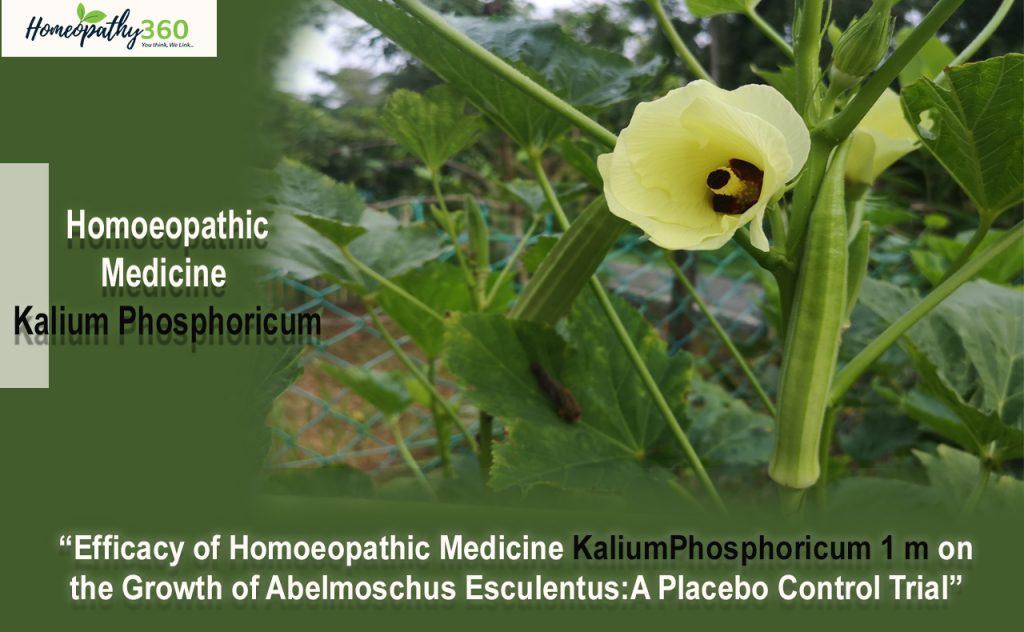
ABSTRACT
BACKGROUND: The present experiment entitled “EFFICACY OF HOMOEOPATHIC MEDICINE KALIUM PHOSPHORICUM 1M ON THE GROWTH OFABELMOSCUS ESCULENTS: A PLACEBO CONTROL TRIAL” was carried out during spring season in the month of February 2023 at Government Homoeopathic Medical College, Bhopal (M.P.).This study comprised of two groups, experimental & control group. There are five plants of each group experimental group &control group. Each plant was observed for morphological, phenological, yield, quality parameters. Observations were recorded by calculating mean values from data obtained by each plant of various potencies.
AIM:To assess the efficacy of Homoeopathic medicine Kalium phosphoricum 1M on the growth of Abelmoschus esculentus: A Placebo Controlled Trial.
PRIMARY OBJECTIVES:
1.To increase growth rate of a plant (Plant Productivity) by applying Homoeopathic Dilution.
2.To increase fruit/flower production using Homoeopathic Dilution.
3.To reduce the use of chemical fertilizers & pesticides with the help of Agro-Homoeopathy.
SECONDARY OBJECTIVES:
1.To increase the soil fertility.
2.Disease control in plants.
INCLUSION CRITERIA: Healthy, High quality NSC Green Okra Seeds (Farm Sona) are taken from National Seed Corporation, Govind-Pura, Bhopal.
EXCLUSION CRITERIA: Unhealthy, fresh seeds are excluded.
METHODOLOGY: Okra plants are cultivated in a plastic grow bags. Seeds are sown after a spray of medicine Kalium phosphoricum 1M dilution in a depth of 2-3cm on12th February 2023. Among these experimental group receives Kalium phosphoricum 1M (10 drops in 1 liter of water) divided into 5 plants at every alternate day while other group (control) receives tap water 1 liter in all 5 plants every alternate day. After 6 Months the entire plant will be measured for plant height in centimeter, number of branches, days taken to 50% flowering, pod length in centimeter, fruit yield per plant and tenderness of fruit and mean values were taken for analysis.
RESULT:On the basis of results, the present study is summarized as follows:
PLANT HEIGHT- The plant height increased significantly with the increase in crop growth stages. After 60,120 days from sowing, a positive effect was seen on plant height in the plants receiving Homoeopathic dilution of Kalium phosphoricum 1M and no such effect was seen in control group.
NUMBER OF BRANCHES- The data clearly indicated that the number of branches per plant of okra responded significantly to Kalium phosphoricum 1M at all the growth stages under study. At 30 days after sowing experimental group exhibited single stem, no branches occur up to 30 days after sowing in control group. As regard to 120 days after sowing, a positive effect was seen on the growth of 1M. Whereas, no such significant changes were seen in control group.
DAYS TAKEN TO 50% FLOWERING- The early 50% flowering days was recorded in 1M which is 44 days while late 50% flowering days was recorded in control group which is 53 days. The variation in days taken to 50% flowering in different groups may possibly due to variation in level of gibberellins in the plant.
POD LENGTH- A positive effect was seen on the pod length of the plants receiving Kalium phosphoricum 1M whereas, no significant changes was seen on the pod length of plants in control group.
FRUIT YIELD- It is revealed that the fruit yield per plant was significantly influenced by Kalium phosphoricum 1M was found significantly superior.
KEYWORDS: Agriculture, Homoeopathy, Kalium phosphoricum.
INTRODUCTION: A variety of human ailments have been effectively treated by Homoeopathy, a discipline of medicine. According to Dutch Homoeopathy, treating plants is similar to treating people. In the future, using Homoeopathic treatments will be quite advantageous. Agro-homoeopathy is a cutting-edge technology that treats a variety of disorders in the agriculture industry using an unorthodox method.Through the use of Homoeopathy, biotic and abiotic stresses (such as salt stress, drought stress, cold stress, metal toxicity, mechanical damages, etc.) have also been somewhat eliminated. In addition to lowering costs, this lessens the toxicity to the plants. [1] According to the textbooks on Homoeopathy, Homoeopathic preparations are diluted and mechanically agitated (potentized) substances that are given based on the similitude (like cures like) premise. The Decimal, Centennial, and 50-millesimal scales are the three basic scale types that are employed. These three scales are denoted by the letters D or X for decimal, C for centesimal, and LM for fifty millesimal. In the case of the decimal scale, substance is diluted by 1/10 at each stage, 1/100 for the centesimal scale, and 1/50000 for the 50-milesimal scale. The Hahnemannian procedures (DH, CH) and other dilution methods fall into two main types. The Hahnemannian dilutions are occasionally just given the letters D or C as names. Each new vial is used for a dilution stage when employing the Hahnemannian method. Dilution and Succession, two essential processes in the Homoeopathic therapy process, require only a little amount of technical knowledge. Mother tinctures, which are typically the first ingredient in homoeopathic medications, are most frequently made through maceration and percolation. For solids, the process is started by triturating the item with lactose powder in a mortar. The combination ratio will also be in the range of 1/10 or 1/100 (1 gram of the drug substance is mixed with 9 grams of lactose for the decimal scale and 99 grams of lactose for the centesimal scale).
Agro-homoeopathy is essential because the use of agrochemicals, particularly pesticides and insecticides, frequently results in farm worker injuries and occasionally fatalities.It is possible to prevent the obvious danger to human life. The ecosystem can regenerate more quickly using Homoeopathic potencies without endangering people or the environment. [2] By repairing the damage that chemical fertilizers and pesticides have already done to the soil, Agro-homoeopathy can further minimize abiotic stress, which includes low temperature, insufficient or excessive water, high/low salinity, heavy metals, and UV radiation in plants. A variety of data that has been scientifically verified supports the relevance of applying dynamizations to plants before and during planting, which further encourages plant growth and output.[3]
Homoeopathy in agriculture, is a solution that can help with problems caused by the use of chemicals. The goal of this study is to compare howHomoeopathic remedy Kalium phosphoricum 1M affect plant growth and productivity.
The use of Homoeopathy in agriculture has been transforming traditional agriculture into agroecological through the administration of Homoeopathic preparations in various dynamizations. Spraying homoeopathic medications on the soil or leaves is an option. Safe uses of Homoeopathic dilutions and trituration include seed germination, soil health enhancement, seedling growth, flowering, fruiting, disease prevention, and stress management. It is crucial to choose the right Homoeopathic remedy for each plant in order to maximize efficiency and profitability.
QUESTION TO BE ANSWERED HYPOTHESIS:Null hypothesis & Relational Hypothesis
NULL HYPOTHESIS: Null hypothesis shows that there will be no effectof Kalium phosphoricum 1M on plant growth, yield & development of Okra plant.
RELATIONAL HYPOTHESIS: This hypothesis will show significant amount of various potencies of Kalium phosphoricum on the growth, yield and development of okra plant.
MATERIAL AND METHODS MATERIALS:
1. Okra seeds
2.Pots (plastic) 10
3.Spray bottle
4. Watering can
5. HomoeopathicDilution- Kalium phosphoricum 1M
6. Hand gloves, masks
7. Stirrer
8. Beaker
METHODOLOGY:Plants are cultivated in a plastic grow bags. Seeds are sown after a spray of medicine Kalium phosphoricum 1M in a depth of 2-3cm on 12th February 2023. Among these experimental group receives Kalium phosphoricum 1M (10 drops in 1 liter of water) divided into 5 plants of respective potencies was given at every alternate daywhile other group (control) receives normal water 1 liter in all 5 plants every alternate day with the help of watering can. After 6 months the entire plants will be measured for plant height in centimeter, number of branches, days taken to 50% flowering, pod length in centimeter, fruit yield per plant in grams & tenderness of fruit.
DOSAGE & REPITATION:
Experimental group: 10 drops in 1 liter of water every alternate day in each 5 plants of respective potencies.
Control group:Normal water 1 liter in each 5 plants every alternate day by watering can.
STUDY DESIGN:A Prospective, Interventional, Qualitative, two parallel arm study will be performed to evaluate effect of Kalium phosphoricum 1M on plant productivity. The result will be analyzed comparing the mean values of both the groups after 6 months.
STUDY DURATION:The study was aimed at- To evaluate effect of Kalium phosphoricum 1M on Okra plant was undertaken from February to July 2023 at Government Homoeopathic Medical College and Hospital, Bhopal. Total duration of study was 6 Months.
STUDY SITE: G.H.M.C. it is located in the vicinity of Bhopal city. Okra seeds were sown in plastic grow bags to avoid any bias, each bag is of equal size. Seeds were sown in a depth of 2-3cm after a spray of respective medicine of each potency in a month of February 2023
SUMMARY
The present investigation entitled “EFFICACY OF HOMOEOPATHIC MEDICINE KALIUM PHOSPHORICUM 1M ON THE GROWTH OFABELMOSCUS ESCULENTS: A PLACEBO CONTROL TRIAL” was carried out on February-July of 2023 at Govt. Homoeopathic Medical College and Hospital, Bhopal, (M.P.). The present experiment was comprised of two groups experimental and control group. Individual plant was sown in plastic grow bags to observe morphological, phenological, yield, quality parameters. Observations were recorded by calculating the mean values. Results obtained separately by observing mean values from each plant of experimental and control group. Each plant was evaluated separately for morphological, phenological, yield and quality parameters as per standard procedures.
On the basis of results obtained, the present investigation is summarized as follows:
1.PLANT HEIGHT-The plant height increased significantly with the increase in crop growth stages. After 60 days from sowing, no major effect was seen on plant height in control group. After 120 days from sowing, positive effect was seen on the growth of 1M and no such effect was seen in control group. At 60 and 120 days after sowing,1M potency of Kalium phosphoricum was found to be superior from control group.
2.NUMBER OF BRANCHES-At 30 days after sowing, all the potencies exhibited single stem no branches occur up to 30 days after sowing. As regard to 120 days after sowing, a positive effect was seen on the growth of plant receiving Kalium phosphoricum 1M. Whereas, no such significant changes were seen in plants receiving normal water.
3.50% FLOWERING-The early 50% flowering days was recorded in 1M which is 44 days while late 50% flowering days was recorded in control group which is 53 days.
4.POD LENGTH-A positive effect was seen on the pod length of 1M potency whereas, no significant changes were seen on the pod length of control group.
5. FRUIT YIELD-As regard to fruit yield per plant was significantly influenced by1M potency of Kalium phosphoricum and was found significantly superior with 65 fruits/plant andin control groupyield was 56 fruits/plant. It is revealed that the fruit yield per plant was significantly influenced by 1M potency of Kalium phosphoricum.
7. QUALITY OF FRUIT-Talking about tenderness of the fruits, experimental group has 30% fruits which were hard and rest 70% fruits are soft while fruits belonging to control group are comparatively harder.
CONCLUSION :
Agro-homoeopathy is a chemical-less (chemical free) and non-toxic method for crop cultivation. In the present study, the application of potentized Homoeopathic medicine Kalium phosphoricum 1M on Abelmoschus esculentus exhibited a beneficial result by increasing plant height, number of branches, days to 50% flowering, fruit yield, pod length and tenderness of fruit. From this experiment we can conclude that Agro-homoeopathy may be a good choice in every aspect of agriculture. For proper application of Homoeopathic medicines in agriculture, this avenue needs to be explored with further studies on larger samples, which will help not only in spreading Homoeopathic science in addition to offering a solution for growing concerns relating to growing crops but also minimizes the consequences of chemical fertilizers and pesticides. Agro-homoeopathy is a win- win solution for farmers. They can use this method with confidence that it will neither damage the useful organism, the soil nor the plants. Agrochemical use in horticultural cultivations generates negative effects, thus the need for searching to decrease or eliminate its use by means of other less toxic techniques like Agro-Homoeopathy.
1.Hazrab P. Vegetable Science and Technology. New Delhi: New India Publishing Agency; 2019.
2.Hazrab P. Vegetable Science and Technology. New Delhi: New India Publishing Agency; 2019.





